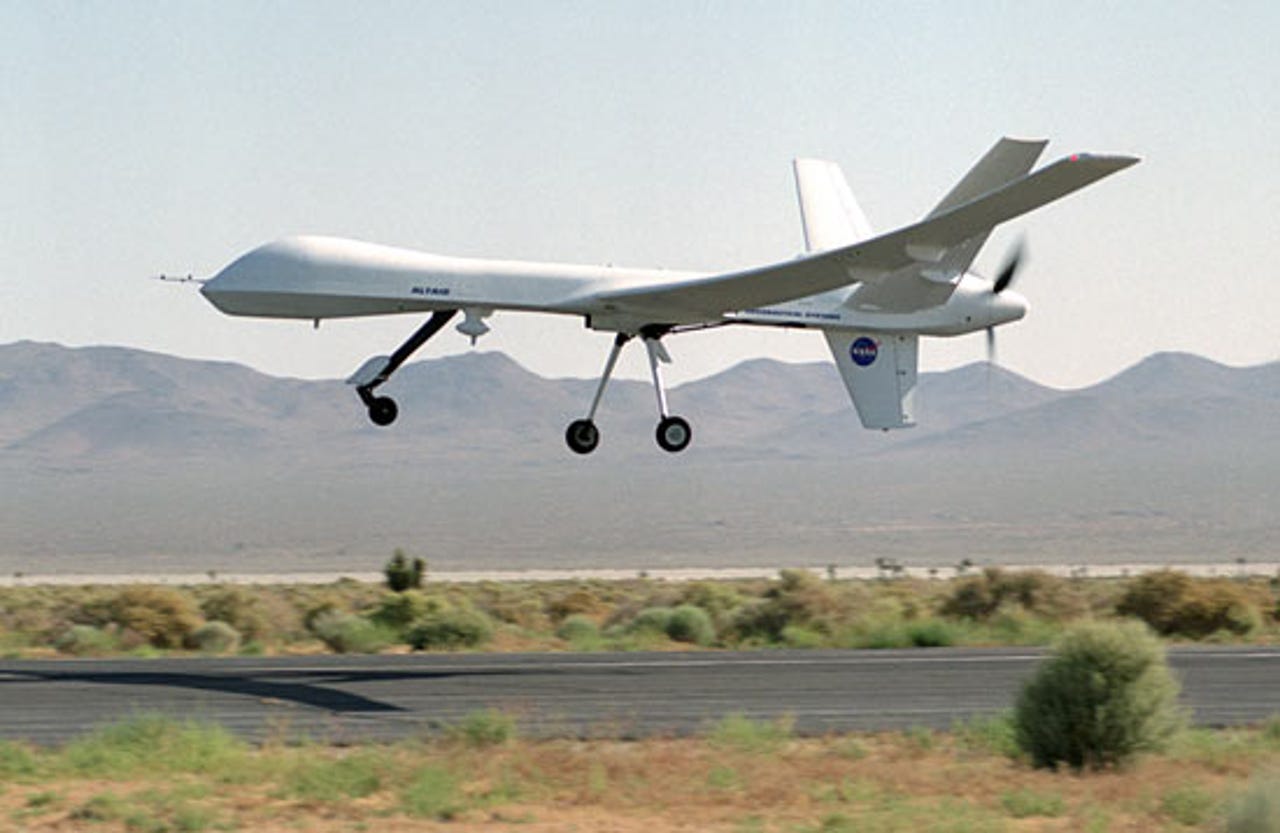Photos: Keeping watch with unmanned aircraft


Altair UAV
This slender-wing aircraft is the Altair UAV, which had its checkout flight in June 2003 at El Mirage, Calif. The Altair was developed for NASA by General Atomics Aeronautical Systems for long-endurance, high-altitude missions. It will be used to test collision-avoidance technologies that are necessary for UAVs to fly in the U.S. national airspace--and share skies with general aviation pilots and commercial flights.
Coastal mapping flight
General Atomics' Altair UAV flew a coastal mapping, mammal observation and marine monitoring mission off the California coast in late 2005. It was organized by NASA and the National Oceanic and Atmospheric Administration, part of the Department of Commerce.
Hermes UAV
The U.S. Department of Homeland Security already is using unmanned aircraft to patrol the Arizona border for illegal immigrants. Pictured here is the Israeli-built Hermes UAV, which has a price tag of around $2 million. It can fly in a radius of 120 miles for 20 hours at a cruising speed of about 90 miles an hour. Sensors can include GPS navigation, daylight video imaging, infrared imaging, laser ranging, radar, and GTMI (Ground Target Motion Indicator) analysis.
CyberBug
The CyberBug, from Cyber Defense Systems of St. Petersburg, Fla., is a hand-launched drone aircraft designed to be a surveillance tool for law enforcement agencies and the military. The cost starts at around $10,000 and includes cameras that can be changed for day or night use.
CyberBug interface
A close-up of the CyberBug's ground control software interface. The drone can fly for up to three and a half hours, depending on the payload, with a top speed of about 20 mph.
Global Hawk UAV
One of the largest UAVs is the Global Hawk, which has a wingspan of 116 feet. (A Cessna 152 has a wingspan of just 34 feet, and a DC-10 has a wingspan of 155 feet.) The U.S. military used the Global Hawk during the invasion of Afghanistan. It can fly at altitudes up to 65,000 feet at about 400 mph with a range of 12,000 nautical miles. Surveillance images are relayed in near-real time through satellites or direct radio links. The 12th Reconnaissance Squadron pictured here is the home unit for the Global Hawk mission.
Long haul Hawk
The Air Force's Global Hawk made aerospace history as the first UAV to fly without refueling 7,500 miles from Edwards Air Force Base, Calif., to Australia.
Raven UAV
Spc. Michael Rodenberg, left, and Sgt. Joshua Harris, perform preflight checks of the Raven UAV. This tiny UAV, with a wingspan of 4.5 feet, flies its missions at about 100 to 300 feet above ground level. It can be flown by remote control or programmed to go to preset GPS waypoints, and is being used in the occupation of Iraq.
Predator UAV
The Air Force describes the Predator UAV as a "medium-altitude, long-endurance, remotely piloted aircraft." It can carry two laser-guided Hellfire anti-tank missiles. It's been used on air strikes against suspected terrorists in Afghanistan and Pakistan. Cruising speed is 84 mph with an endurance of 16 to 40 hours.
Reconnaissance simulation
This Predator UAV is shown above the aircraft carrier USS Carl Vinson (CVN 70) on a simulated Navy aerial reconnaissance flight off the coast of southern California. This was the Predator's first maritime mission with a carrier battle group, and it was launched from San Nicholas Island off the coast of southern California.
UAVs on the big screen
UAVs have already become Hollywood stars. The 2005 action flick "Stealth" featured a UAV with artificial intelligence nicknamed "EDI." After it's struck by lightning, EDI develops a mind of its own.
Desert Hawk
Staff Sgt. James Ellis adjusts the camera in a Desert Hawk at the Tallil Air Base in Iraq. Developed by Lockheed Martin, the Desert Hawk is launched into the air using a bungee cord as a slingshot and is designed to circle over air bases and help with security by showing possible threats up to about 6 miles away. It includes an electric motor, color or infrared cameras, and a GPS receiver.
Corax
The recently unveiled Corax unmanned vehicle, from BAE Systems, draws on the design of Stealth aircraft.